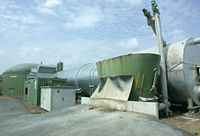
Photo from wikipedia
Municipal waste treatment is inherently associated with odour emissions. The compounds characteristic of the processes used for this purpose, and at the same time causing a negative olfactory sensation, are… Click to show full abstract
Municipal waste treatment is inherently associated with odour emissions. The compounds characteristic of the processes used for this purpose, and at the same time causing a negative olfactory sensation, are organic and inorganic sulphur and nitrogen compounds. The tests were carried out at the waste management plant, which in the biological part, uses the methane fermentation process and is also equipped with an installation for the collection, treatment, and energetic use of biogas. The tests include measurements of the four odorant concentrations and emissions, i.e., volatile organic compounds (VOCs), ammonia (NH 3 ), hydrogen sulphide (H 2 S), and methanethiol (CH 3 SH). Measurements were made using a MultiRae Pro portable gas detector sensor. The tests were carried out in ten series for twenty measurement points in each series. The results show a significant impact of technological processes on odorant emissions. The types of waste going to the plant are also important in shaping this emission. On the one hand, it relates to the waste collection system and, on the other hand, the season of year. In addition, it has been proved that the detector used during the research is a valuable tool enabling the control of technological processes in municipal waste processing plants.
Journal Title: Sustainability
Year Published: 2020
Link to full text (if available)
Share on Social Media: Sign Up to like & get
recommendations!